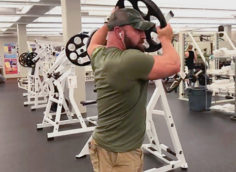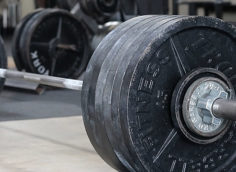The barbell overhead press is one of the best exercises for building shoulder size, total-body strength, and shoulder stability. But it may not be appropriate for everyone.
Some people aren't built to effectively and safely perform the overhead press with a bar. A structural or technical limitation could cause that. The lift should never be painful. (If it's always painful, get checked out by a pro.)
Those who struggle with a technical deficiency should take a step back and identify weaknesses or common misfires. We'll go over those later. First, let's look at some safe and effective overhead press variations:
Using a neutral grip allows some stress to be taken off the shoulders, placing it more on the triceps and other supporting muscles. The neutral position provides a more natural groove for many lifters and helps them get into a proper, stronger overhead position.
Swiss Bar Overhead Press: If you don't have access to a strongman log, a Swiss bar is the next best option. It gives you multiple grips to choose from, so you can mix it up. The bar will affect your starting position, causing you to be in more of an arch.
Hex/Trap Bar Overhead Press: Using a rackable hex or trap bar is extremely difficult and unique. The bar will allow for a greater range of motion since your head is centered. You'll need to really fight for stability in the lockout position.
Dumbbell Neutral-Grip Overhead Press: Dumbbells improve strength symmetry. If one arm is stronger than the other, dumbbells will let you know. They also move more freely than a bar. Kettlebells would work too.
Pressing from pins allows you to focus more on the concentric or "up" phase and less on the straining eccentric or "down" phase. This will give you time to reset and perfect each rep. The pins can be set below, above, or right at chin level to achieve different goals.
Barbell Overhead Pin Press: Think of this as a dead-stop press. You don't have to hold the bar in place to start the lift. You get to create pure concentric strength. You may not get the full benefits of the standard barbell overhead press, but the pin press might allow you to keep lifting. That's a win.
Swiss and Hex Bar Overhead Pin Press: Pin presses using the neutral grip provided by these bars is a win-win.
Pinned Z Press with Barbell: The Z press is an overhead press performed from a seated position with your legs out wide. This position is a great test of mobility and control. You'll use less weight but really get to focus on intent.
These are great because you're building shoulder stability, necessary for upper-body health and lifting longevity. Chaotic variations build your upper back, traps, and shoulders better than traditional stable pressing. They're performed with less load, but they'll seem even more difficult.
Kettlebell Bottoms-Up Press (standing and half-kneeling): This is the ultimate movement for shoulder stability. It requires light weight and maximum intent. You'll build the smaller stabilizer muscles of the shoulder.
Chaotic Barbell Overhead Press: This is a decent substitute if you don't have a bamboo or Earthquake Bar.
Chain Overhead Press: The load will be the lightest in the bottom position, where there's a lot of stress on the shoulders. As the chain rises off the floor, the load gets heavier as you approach lockout.
The landmine press is a hybrid press. It's not completely vertical or horizontal. The single and double-arm variations are the standards.
2 Up, 1 Down Landmine Press: This will allow you to overload the eccentric portion on a single arm and still get the concentric pressing benefits of pressing with two arms. Since the angle of the bar path has changed, loading the eccentric phase isn't as grueling on the shoulders.
Half-Kneeling Single-Arm Landmine Press: This is more challenging to your trunk strength and will force you to focus more on the stability of the midsection and shoulders.
Seated Z Press with Landmine, Double or Single-Arm: Just don't drop the bar on yourself. This is a great movement to perform with a partner.
Here are some of the most common technical issues and misfires:
- Not Pushing Your Head Through. Strive for a vertical bar path. Don't let the bar move too far forward and put unnecessary stress on the shoulders. As the bar begins driving up and past your face, push your head through the path to lock out the bar directly overhead.
- Lack of Thoracic and Shoulder Mobility. We live in a slouched, anterior-dominant world, so work on mobilizing the shoulders and the thoracic spine every workout. Better mobility will help you enhance your ability to overhead press. Plus, it'll make you feel better.
- Lack of Total Body Tension. Create global, total body tension. Root your feet firmly into the ground, creating a stable base from which to press, and squeeze the glutes, trunk, and barbell hard. If you don't maintain this tension, you'll have an excessive arch in the lower back as the bar gets driven up. Not good for performance or back health.
- Poor Positioning. Maintain a strong upper body posture; don't round the upper back. Take a strong grip, keeping the wrists stacked under the elbows. Don't allow the wrists to bend backward, and prevent the elbows from flaring outwards when pressing.
If you suffer from any of these misfires, address them first.





